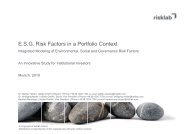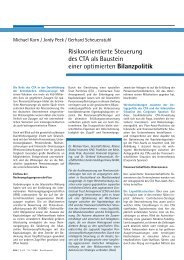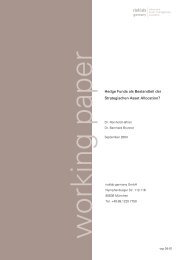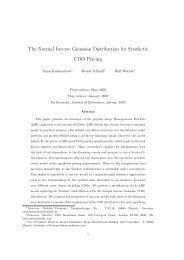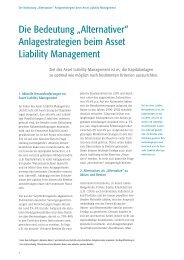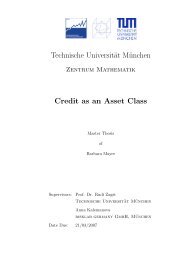Technical University Munich Commodities as an Asset Class - risklab
Technical University Munich Commodities as an Asset Class - risklab
Technical University Munich Commodities as an Asset Class - risklab
Create successful ePaper yourself
Turn your PDF publications into a flip-book with our unique Google optimized e-Paper software.
2.3 Trading <strong>Commodities</strong><br />
Historically, the expiration months of futures contracts were without some exceptions<br />
March, June, September <strong>an</strong>d December reflecting the se<strong>as</strong>onality in commodities<br />
markets. This h<strong>as</strong> ch<strong>an</strong>ged with growing markets. Today there are contracts<br />
for every delivery month <strong>an</strong>d long term maturities until 5 years available.<br />
As we mentioned introductory, futures trading h<strong>as</strong> grown rapidly. For inst<strong>an</strong>ce, the<br />
New York Merc<strong>an</strong>tile Exch<strong>an</strong>ge (NYMEX) Crude Oil Future is me<strong>an</strong>while listed<br />
under the 20th most often traded future contracts worldwide with a trading volume<br />
of over 50 million contracts in 2005. This w<strong>as</strong> <strong>an</strong> incre<strong>as</strong>e of around 15%. Its main<br />
competitor Brent crude oil futures contract, follows with clear dist<strong>an</strong>ce. Although<br />
its trading volume went up 17% in 2005 it only could reach a volume of 25 million<br />
traded contracts. Over this electronic trading is coming up what will additionally<br />
boost trading volume in the next years. 47<br />
The metals markets showed the same picture. The trading of gold at the NYMEX<br />
went up over 6% in 2005 to approximately 13 million traded contracts. The London<br />
Metal Exch<strong>an</strong>ge (LME) surp<strong>as</strong>sed Sh<strong>an</strong>ghai with the most copper futures traded<br />
worldwide, with volume up approximately 4% to over 16 million.<br />
The agricultural trading h<strong>as</strong> grown <strong>as</strong> well. Surprisingly, putting future <strong>an</strong>d option<br />
contracts in volume together it h<strong>as</strong> the highest trading volume of all commodity<br />
groups. Although the Asi<strong>an</strong> trading volume went down in 2005 the US exch<strong>an</strong>ges<br />
registered strong incre<strong>as</strong>es: the Chicago Board of Trade (CBOT) corn future went<br />
up 14% to over 23 million traded contracts, the CBOT wheat future went up 25% to<br />
over 8 million traded contracts <strong>an</strong>d the New York Board of Trade sugar #1 future<br />
went up 20% to over 12 million traded contracts.<br />
2.3.1.2 Options<br />
Commodity options are options where the underlying <strong>as</strong>set is a commodity or commodity<br />
index. In contr<strong>as</strong>t to futures contracts they certify the right but not the<br />
duty to buy or sell <strong>an</strong> <strong>as</strong>set at some future point.<br />
Commodity options are identical to options on traditional <strong>as</strong>sets such <strong>as</strong> stocks <strong>an</strong>d<br />
are primary used to m<strong>an</strong>age risk or to generate premium income through <strong>as</strong>ymmetric<br />
risk exposure. Nowadays, stock options are more common th<strong>an</strong> commodity options.<br />
Nevertheless the options concept w<strong>as</strong> originally developed in commodity markets.<br />
First historical traditions go back to the mathematici<strong>an</strong>, philosopher <strong>an</strong>d <strong>as</strong>tronomer<br />
47 Data source: Futures Industry Magazine J<strong>an</strong>/Feb 2006<br />
35



